Armonk, N.Y., USA - August 18, 2011 - Today, IBM (NYSE: IBM) researchers unveiled a new generation of experimental computer chips designed to emulate the brain's abilities for perception, action and cognition. The company and its university collaborators also announced they have been awarded approximately $21 million in new funding from the Defense Advanced Research Projects Agency (DARPA) for Phase 2 of the Systems of Neuromorphic Adaptive Plastic Scalable Electronics (SyNAPSE) project.
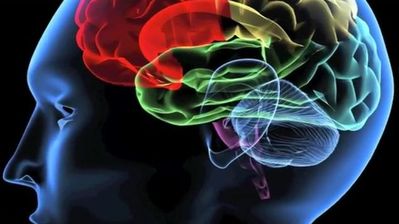 |
Today's computers are little better than calculators; ruled by the von Neumann architecture for over half a century, they use storage structures and programmable memory that scientists are endlessly aiming to improve. However, the human brain - the world's most sophisticated computer - can perform complex tasks rapidly and accurately using the same amount of energy as a 20 watt light bulb and consuming as much space as a 2 liter bottle of soda.
Researchers at IBM and collaborating universities are working to build cognitive systems that can learn and perform complex tasks such as action, recognition and perception, while rivaling the low energy and power consumption of the human brain.
IBM’s long-term goal is to build a chip system with ten billion neurons and hundred trillion synapses, while consuming merely one kilowatt of power and occupying less than two liters of volume.
Courtesy of IBM |
| |
Armonk, N.Y., USA - August 18, 2011
Today, IBM (NYSE: IBM) researchers unveiled a new generation of experimental computer chips designed to emulate the brain’s abilities for perception, action and cognition.
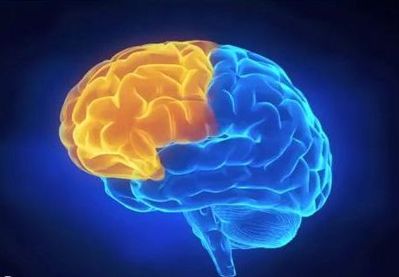 |
Researchers at IBM and collaborating universities are working to build cognitive systems that can learn and perform complex tasks such as action, recognition and perception, while rivaling the low energy and power consumption of the human brain.
IBM’s long-term goal is to build a chip system with ten billion neurons and hundred trillion synapses, while consuming merely one kilowatt of power and occupying less than two liters of volume.
Courtesy of IBM |
| |
The technology could yield many orders of magnitude less power consumption and space than used in today’s computers.
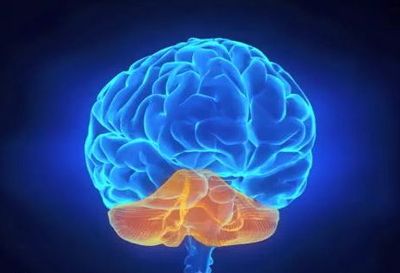 |
Researchers at IBM and collaborating universities are working to build cognitive systems that can learn and perform complex tasks such as action, recognition and perception, while rivaling the low energy and power consumption of the human brain.
IBM’s long-term goal is to build a chip system with ten billion neurons and hundred trillion synapses, while consuming merely one kilowatt of power and occupying less than two liters of volume.
Courtesy of IBM |
| |
In a sharp departure from traditional concepts in designing and building computers, IBM’s first neurosynaptic computing chips recreate the phenomena between spiking neurons and synapses in biological systems, such as the brain, through advanced algorithms and silicon circuitry.
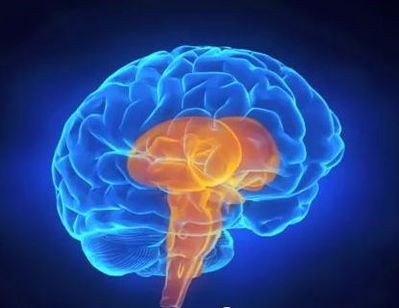 |
Researchers at IBM and collaborating universities are working to build cognitive systems that can learn and perform complex tasks such as action, recognition and perception, while rivaling the low energy and power consumption of the human brain.
IBM’s long-term goal is to build a chip system with ten billion neurons and hundred trillion synapses, while consuming merely one kilowatt of power and occupying less than two liters of volume.
Courtesy of IBM |
| |
Its first two prototype chips have already been fabricated and are currently undergoing testing.
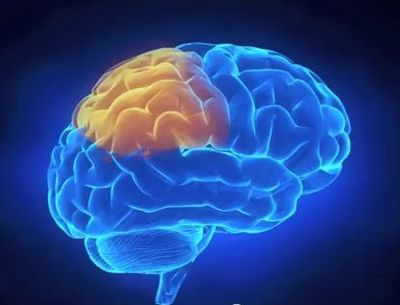 |
Researchers at IBM and collaborating universities are working to build cognitive systems that can learn and perform complex tasks such as action, recognition and perception, while rivaling the low energy and power consumption of the human brain.
IBM’s long-term goal is to build a chip system with ten billion neurons and hundred trillion synapses, while consuming merely one kilowatt of power and occupying less than two liters of volume.
Courtesy of IBM |
| |
Called cognitive computers, systems built with these chips won’t be programmed the same way traditional computers are today.
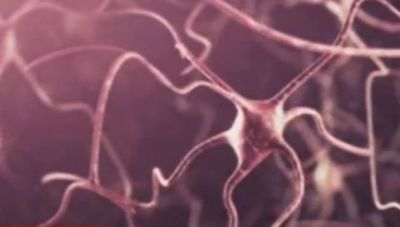 |
Researchers at IBM and collaborating universities are working to build cognitive systems that can learn and perform complex tasks such as action, recognition and perception, while rivaling the low energy and power consumption of the human brain.
IBM’s long-term goal is to build a chip system with ten billion neurons and hundred trillion synapses, while consuming merely one kilowatt of power and occupying less than two liters of volume.
Courtesy of IBM |
| |
Rather, cognitive computers are expected to learn through experiences, find correlations, create hypotheses, and remember – and learn from – the outcomes, mimicking the brains structural and synaptic plasticity.
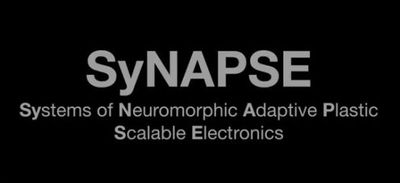 |
| Courtesy of IBM |
| |
To do this, IBM is combining principles from nanoscience, neuroscience and supercomputing as part of a multi-year cognitive computing initiative.
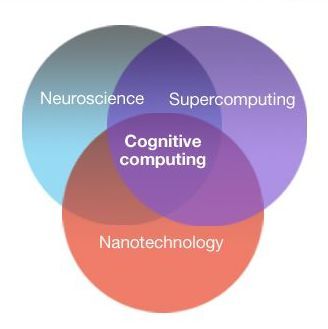 |
Cognitive computing: thought for the future.
Making sense of real-time input flowing in at a dizzying rate is a Herculean task for today's computers, but would be natural for a brain-inspired system. Using advanced algorithms and silicon circuitry, cognitive computers learn through experiences, find correlations, create hypotheses, and remember - and learn from - the outcomes.
For example, a cognitive computing system monitoring the world's water supply could contain a network of sensors and actuators that constantly record and report metrics such as temperature, pressure, wave height, acoustics and ocean tide, and issue tsunami warnings based on its decision making.
Courtesy of IBM |
| |
The company and its university collaborators also announced they have been awarded approximately $21 million in new funding from the Defense Advanced Research Projects Agency (DARPA) for Phase 2 of the Systems of Neuromorphic Adaptive Plastic Scalable Electronics (SyNAPSE) project.
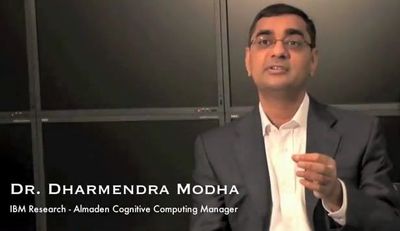 |
Dr. Dharmendra Modha, project leader for IBM Research. Manager of cognitive computing at IBM Almaden Research Center.
Courtesy of IBM |
| |
The goal of SyNAPSE is to create a system that not only analyzes complex information from multiple sensory modalities at once, but also dynamically rewires itself as it interacts with its environment – all while rivaling the brain’s compact size and low power usage.
The IBM team has already successfully completed Phases 0 and 1.
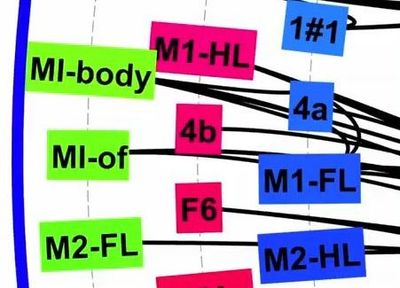 |
Researchers at IBM and collaborating universities are working to build cognitive systems that can learn and perform complex tasks such as action, recognition and perception, while rivaling the low energy and power consumption of the human brain.
Courtesy of IBM |
| |
“This is a major initiative to move beyond the von Neumann paradigm that has been ruling computer architecture for more than half a century,” said Dr. Dharmendra Modha, project leader for IBM Research.
“Future applications of computing will increasingly demand functionality that is not efficiently delivered by the traditional architecture. These chips are another significant step in the evolution of computers from calculators to learning systems, signaling the beginning of a new generation of computers and their applications in business, science and government.”
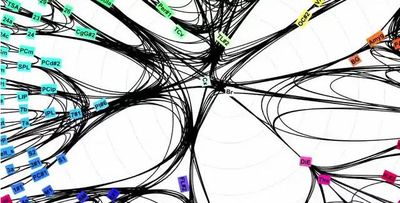 |
Researchers at IBM and collaborating universities are working to build cognitive systems that can learn and perform complex tasks such as action, recognition and perception, while rivaling the low energy and power consumption of the human brain.
Courtesy of IBM |
| |
Neurosynaptic Chips
While they contain no biological elements, IBM’s first cognitive computing prototype chips use digital silicon circuits inspired by neurobiology to make up what is referred to as a “neurosynaptic core” with integrated memory (replicated synapses), computation (replicated neurons) and communication (replicated axons).
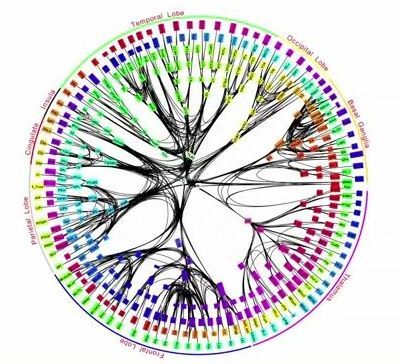 |
Researchers at IBM and collaborating universities are working to build cognitive systems that can learn and perform complex tasks such as action, recognition and perception, while rivaling the low energy and power consumption of the human brain.
Courtesy of IBM |
| |
IBM has two working prototype designs.
Both cores were fabricated in 45 nm SOI-CMOS and contain 256 neurons.
One core contains 262,144 programmable synapses and the other contains 65,536 learning synapses.
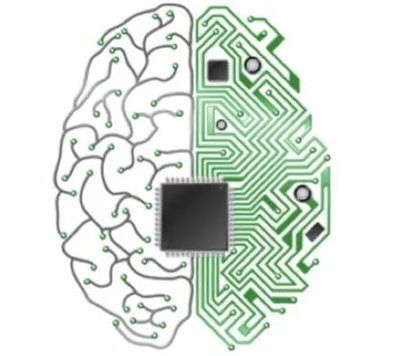 |
Researchers at IBM and collaborating universities are working to build cognitive systems that can learn and perform complex tasks such as action, recognition and perception, while rivaling the low energy and power consumption of the human brain. IBM’s first neurosynaptic computing chips recreate the phenomena between spiking neurons and synapses in biological systems, such as the brain, through advanced algorithms and silicon circuitry.
IBM’s long-term goal is to build a chip system with ten billion neurons and hundred trillion synapses, while consuming merely one kilowatt of power and occupying less than two liters of volume.
Courtesy of IBM |
| |
The IBM team has successfully demonstrated simple applications like navigation, machine vision, pattern recognition, associative memory and classification.
IBM’s overarching cognitive computing architecture is an on-chip network of light-weight cores, creating a single integrated system of hardware and software.
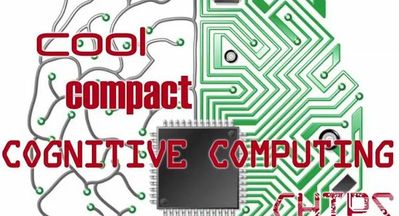 |
Researchers at IBM and collaborating universities are working to build cognitive systems that can learn and perform complex tasks such as action, recognition and perception, while rivaling the low energy and power consumption of the human brain. IBM’s first neurosynaptic computing chips recreate the phenomena between spiking neurons and synapses in biological systems, such as the brain, through advanced algorithms and silicon circuitry.
IBM’s long-term goal is to build a chip system with ten billion neurons and hundred trillion synapses, while consuming merely one kilowatt of power and occupying less than two liters of volume.
Courtesy of IBM |
| |
This architecture represents a critical shift away from traditional von Neumann computing to a potentially more power-efficient architecture that has no set programming, integrates memory with processor, and mimics the brain’s event-driven, distributed and parallel processing.
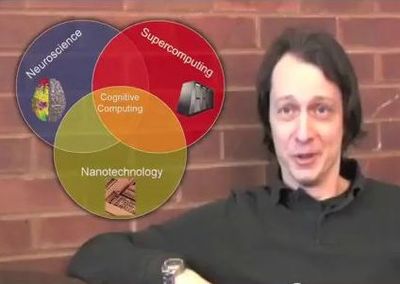 |
Prof. Stefano Fusi, Center for Theoretical Neuroscience, Columbia University.
Courtesy of IBM |
| |
IBM’s long-term goal is to build a chip system with ten billion neurons and hundred trillion synapses, while consuming merely one kilowatt of power and occupying less than two liters of volume.
Why Cognitive Computing
Future chips will be able to ingest information from complex, real-world environments through multiple sensory modes and act through multiple motor modes in a coordinated, context-dependent manner.
 |
Dr. Dharmendra Modha, project leader for IBM Research.
IBM researchers unveiled a new generation of experimental computer chips designed to emulate the brain's abilities for perception, action and cognition.
The technology could yield many orders of magnitude less power consumption and space than used in today's computers.
IBM’s long-term goal is to build a chip system with ten billion neurons and hundred trillion synapses, while consuming merely one kilowatt of power and occupying less than two liters of volume.
Courtesy of IBM |
| |
For example, a cognitive computing system monitoring the world's water supply could contain a network of sensors and actuators that constantly record and report metrics such as temperature, pressure, wave height, acoustics and ocean tide, and issue tsunami warnings based on its decision making.
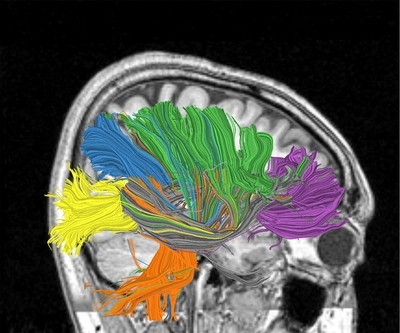 |
IBM scientists and university partners are one step closer to understanding the complex wiring system of the brain with the ultimate goal of building the computer of the future: one that will simulate and emulate the brain’s abilities for sensation, perception, action, interaction and cognition while rivaling its low power consumption and compact size.
Understanding the process behind these seemingly effortless feats of the human brain and creating a computational theory based on it remains one of the biggest challenges for computer scientists.
Courtesy of IBM |
| |
Similarly, a grocer stocking shelves could use an instrumented glove that monitors sights, smells, texture and temperature to flag bad or contaminated produce.
Making sense of real-time input flowing at an ever-dizzying rate would be a Herculean task for today’s computers, but would be natural for a brain-inspired system.
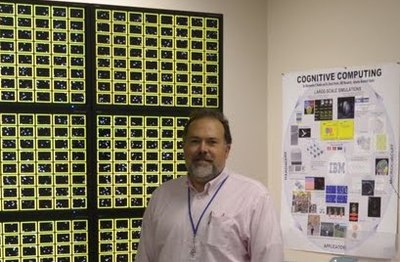 |
SyNAPSE technical project manager Bill Risk.
The Systems of Neuromorphic Adaptive Plastic Scalable Electronics (SyNAPSE) project is driven from funding by the Defense Advanced Research Projects Agency's (DARPA); and entering Phase 2 of the SyNAPSE project (Phases 0 and 1 are complete), IBM has built two state-of-the-art chips unlike anything produced before.
These chips defy the traditional von Neumann architecture, which relies on programs or instructions to complete these tasks.
IBM will use these chips as the basis for an architecture with no set programming.
Courtesy of IBM |
| |
“Imagine traffic lights that can integrate sights, sounds and smells and flag unsafe intersections before disaster happens or imagine cognitive co-processors that turn servers, laptops, tablets, and phones into machines that can interact better with their environments,” said Dr. Modha.
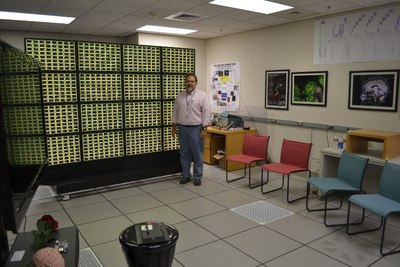 |
SyNAPSE technical project manager Bill Risk next to the "brain wall."
Each of the yellow boxes represents one of the cognitive computing chips (256 neurons), and close up you'll see them blinking - these are neurons firing.
Courtesy of IBM |
| |
For Phase 2 of SyNAPSE, IBM has assembled a world-class multi-dimensional team of researchers and collaborators to achieve these ambitious goals.
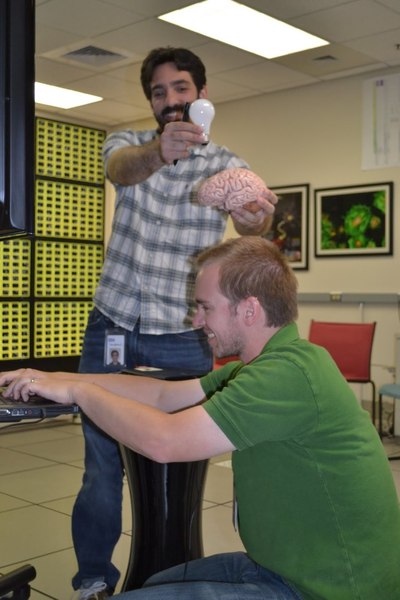 |
IBM researchers Paul Merolla (left) and John Arthur having fun firing up a SyNAPSE demo.
Courtesy of IBM |
| |
The team includes Columbia University; Cornell University; University of California, Merced; and University of Wisconsin, Madison.
 |
Steven Esser, IBM Research - Almaden researcher on the SyNAPSE project, walks through the transformational technology behind cognitive computing.
Courtesy of IBM |
| |
IBM has a rich history in the area of artificial intelligence research going all the way back to 1956 when IBM performed the world's first large-scale (512 neuron) cortical simulation.
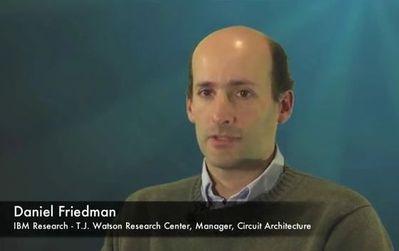 |
Daniel Friedman, IBM Research – T.J. Watson Research Center, Manager, Circuit Architecture.
Courtesy of IBM |
| |
Most recently, IBM Research scientists created Watson, an analytical computing system that specializes in understanding natural human language and provides specific answers to complex questions at rapid speeds.
 |
Dr. Horst Simon, Deputy Director, Lawrence Berkeley National Laboratory.
Researchers at IBM and collaborating universities are working to build cognitive systems that can learn and perform complex tasks such as action, recognition and perception, while rivaling the low energy and power consumption of the human brain.
IBM’s long-term goal is to build a chip system with ten billion neurons and hundred trillion synapses, while consuming merely one kilowatt of power and occupying less than two liters of volume.
Courtesy of IBM |
| |
Watson represents a tremendous breakthrough in computers understanding natural language, “real language” that is not specially designed or encoded just for computers, but language that humans use to naturally capture and communicate knowledge.
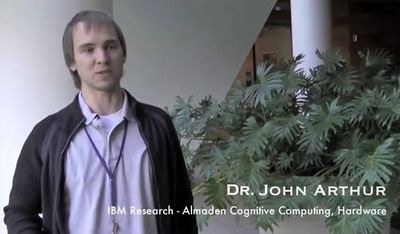 |
Dr. John Arthur, IBM Research – Almaden Cognitive Computing, Hardware.
Courtesy of IBM |
| |
IBM’s cognitive computing chips were built at its highly advanced chip-making facility in Fishkill, N.Y. and are currently being tested at its research labs in Yorktown Heights, N.Y. and San Jose, Calif.
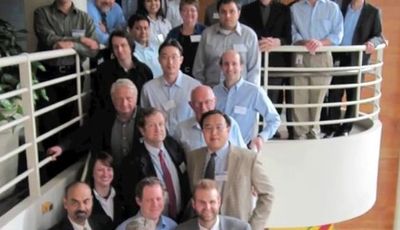 |
Researchers at IBM and collaborating universities are working to build cognitive systems that can learn and perform complex tasks such as action, recognition and perception, while rivaling the low energy and power consumption of the human brain.
IBM researchers unveiled a new generation of experimental computer chips designed to emulate the brain's abilities for perception, action and cognition.
The technology could yield many orders of magnitude less power consumption and space than used in today's computers.
Courtesy of IBM |
| |
For more information about IBM Research, please visit ibm.com/research.
Contact information
Kelly Sims
IBM Media Relations
408-927-1261
kelly.sims@us.ibm.com
Source: IBM
http://www-03.ibm.com/press/us/en/pressrelease/35251.wss
10 things to know about SyNAPSE
1. The brain uses less energy than a 25 watt light bulb and occupies less volume than a 2-liter bottle of soda - capable of completing complex tasks, while autonomously computing what it needs to, and when, and knowing what information to save and for how long. The brain is the ultimate computer.
2. Today's computers use an architecture that was designed 40 years ago. Without using more power and taking up more space, we simply can't program today's computers to do the tasks that are required to handle the growing mountains of data we are faced with.
3. Cognitive computers emulate the brain’s abilities for sensation, perception, action, interaction and cognition, while integrating and analyzing vast amounts of data from many sources at once: in essence the "right brain" to today's "left brain" computers.
4. These systems won’t be programmed like traditional computers are today. Rather, cognitive computers will learn dynamically through experiences, find correlations, create hypotheses and remember – and learn from – the outcomes, emulating the human brain’s synaptic and structural plasticity (or the brain's ability to re-wire itself over time as it learns and responds to experiences and interactions with its environment.)
5. To accomplish this new kind of system, IBM is combining neuroscience, nanoscience and supercomputing together to rival the function, power and space of the brain.
6. Supercomputing: In November 2009, scientists used an IBM Blue Gene supercomputer to achieve significant advances in large-scale cortical simulation of a cat brain, substantiating the feasibility of a cognitive computing chip.
7. Neuroscience: Last year, scientists here at Almaden uncovered and successfully mapped the largest long-distance network of the monkey brain, which is essential for understanding the brain’s behavior, complexity, dynamics and computation. This discovery gives scientists unprecedented insight into how information travels and is stored across the brain.
8. Nanoscience: The revolutionary new chip that we've unveiled is a building block towards the long-term goal of SyNAPSE; to build a chip system with ten billion neurons and hundred trillion synapses, while consuming merely one kilowatt of power and occupying less than two liters of volume.
9. Computers like this could have a significant impact on virtually every sector of the economy. The application and service possibilities will range from preventing fraud and providing better security, to helping scientists better understand intricate climate changes happening to our planet (see callout text).
10. IBM has assembled a world-class team including collaborators from Cornell University, Columbia University, University of California - Merced and University of Wisconsin - Madison, to work with their scientists from IBM Research sites including Austin, TX, Yorktown Heights, NY, India and Zurich.
Source: IBM Research
http://ibmresearchnews.blogspot.com/2011/08/this-cognitive-computing-chip-taught.html
Video
SyNAPSE: IBM Cognitive Computing Project - Overview
http://www.youtube.com/watch?v=BnTUOEwOKYA&feature
Video
IBM's "Brain" Guy: Dharmendra Modha
http://www.youtube.com/watch?v=f74KiwIJvw4
Video
SyNAPSE: IBM Cognitive Computing Project - Hardware
http://www.youtube.com/watch?v=cia3XfQT2fk
Video
SyNAPSE: IBM Cognitive Computing Project - Circuit Architecture
http://www.youtube.com/watch?v=bJ7HVCQmviQ
Video
SyNAPSE: IBM Cognitive Computing Project - Brain vs. Computer
http://www.youtube.com/watch?v=oyQRkCvweFY
Video
SyNAPSE: IBM Cognitive Computing Project - Software
http://www.youtube.com/watch?v=agYJSdMWXYQ
ASTROMAN Magazine – 2011.08.13
IBM Raises Bar, Records Highest Ever TPC-C Benchmark for x86 Servers
http://www.astroman.com.pl/index.php?mod=magazine&a=read&id=1031
ASTROMAN Magazine – 2011.08.06
IBM Develops Full-text Digitization System for National Diet Library of Japan
http://www.astroman.com.pl/index.php?mod=magazine&a=read&id=1027
ASTROMAN Magazine – 2011.07.17
IBM Expands Business in Japan with New Cloud Data Centers
http://www.astroman.com.pl/index.php?mod=magazine&a=read&id=1020
ASTROMAN Magazine – 2011.07.09
IBM Scientists Demonstrate Computer Memory Breakthrough
http://www.astroman.com.pl/index.php?mod=magazine&a=read&id=1014
ASTROMAN Magazine – 2011.06.17
IBM's Watson Computing System Honored as "Person of the Year"
http://www.astroman.com.pl/index.php?mod=magazine&a=read&id=998
ASTROMAN Magazine – 2011.06.12
IBM Scientists Build the First Wafer-Scale Graphene Integrated Circuit Smaller than a Pinhead
http://www.astroman.com.pl/index.php?mod=magazine&a=read&id=995
ASTROMAN Magazine – 2011.06.02
IBM Helps City of Fort Worth and Tarrant County Create a Smarter Public Safety System
http://www.astroman.com.pl/index.php?mod=magazine&a=read&id=985
ASTROMAN Magazine – 2011.05.15
ICM Selects IBM to Fuel National Science
http://www.astroman.com.pl/index.php?mod=magazine&a=read&id=973
ASTROMAN Magazine – 2011.05.08
IBM Commemorates NASA's 50th Anniversary of First U.S. Manned Space Flight
http://www.astroman.com.pl/index.php?mod=magazine&a=read&id=967
ASTROMAN Magazine – 2011.05.01
Yale School of Management and IBM Collaborate to Prepare Students for the Next Generation of Jobs
http://www.astroman.com.pl/index.php?mod=magazine&a=read&id=961
ASTROMAN Magazine – 2011.04.21
IBM Reports 2011 First-Quarter Results
http://www.astroman.com.pl/index.php?mod=magazine&a=read&id=950
ASTROMAN Magazine – 2011.03.18
IBM już od 18 lat najbardziej innowacyjną firmą świata
http://www.astroman.com.pl/index.php?mod=magazine&a=read&id=919
ASTROMAN Magazine – 2011.02.20
IBM to Collaborate with Nuance to Apply IBM's "Watson" Analytics Technology to Healthcare
http://www.astroman.com.pl/index.php?mod=magazine&a=read&id=899
ASTROMAN Magazine – 2011.02.20
IBM "Watson" to Challenge Humans at Jeopardy!
http://www.astroman.com.pl/index.php?mod=magazine&a=read&id=898
ASTROMAN Magazine – 2010.12.25
IBM's "Watson" Computing System to Challenge All Time Greatest Jeopardy! Champions
http://www.astroman.com.pl/index.php?mod=magazine&a=read&id=864
ASTROMAN magazine
|

